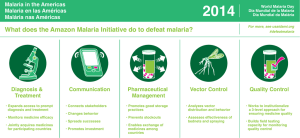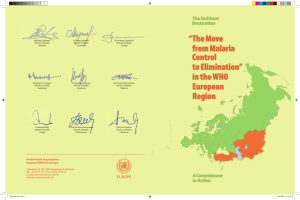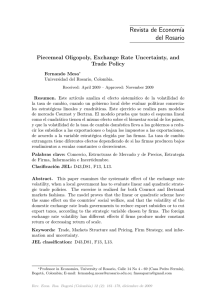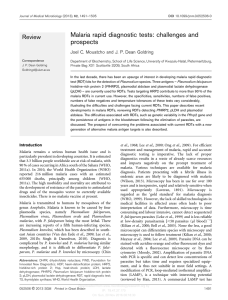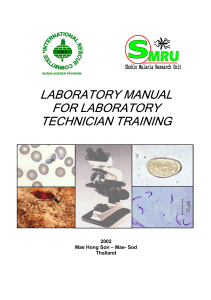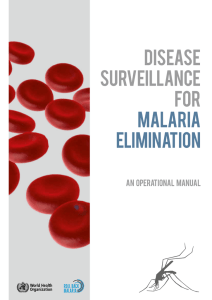a balancing act - The Abdul Latif Jameel Poverty Action Lab
Anuncio
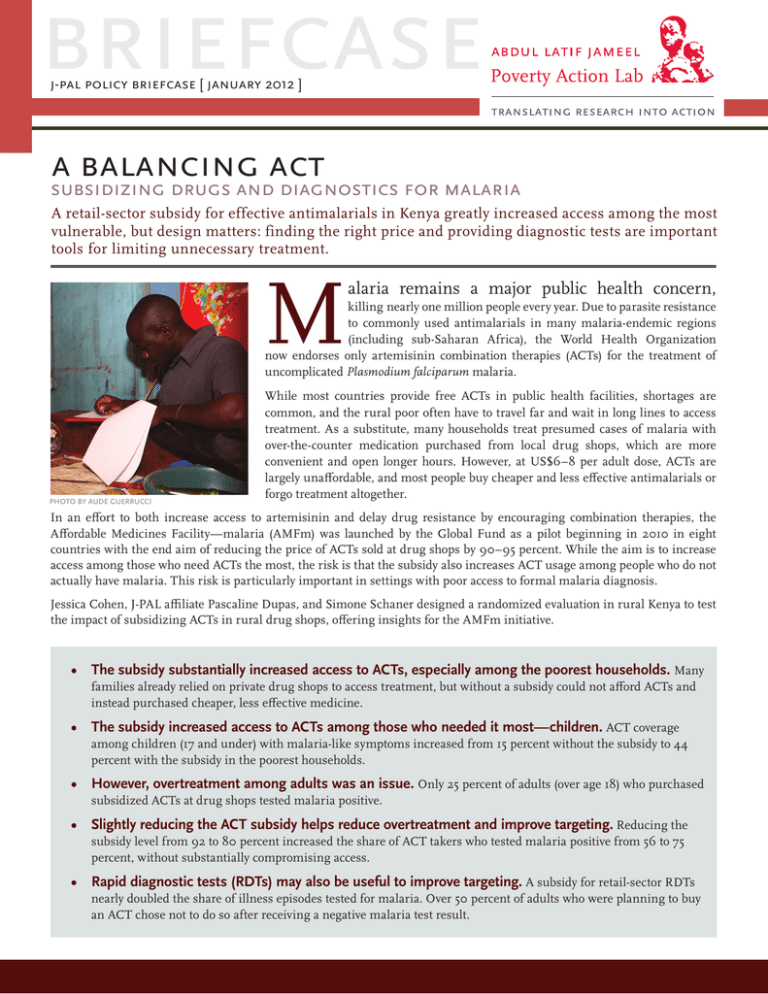
briefcase j-pal policy briefcase [ january 2012 ] a balancing act subsidizing drugs and diagnostics for malaria A retail-sector subsidy for effective antimalarials in Kenya greatly increased access among the most vulnerable, but design matters: finding the right price and providing diagnostic tests are important tools for limiting unnecessary treatment. M alaria remains a major public health concern, killing nearly one million people every year. Due to parasite resistance to commonly used antimalarials in many malaria-endemic regions (including sub-Saharan Africa), the World Health Organization now endorses only artemisinin combination therapies (ACTs) for the treatment of uncomplicated Plasmodium falciparum malaria. PHOTO BY AUDE GUERRUCCI While most countries provide free ACTs in public health facilities, shortages are common, and the rural poor often have to travel far and wait in long lines to access treatment. As a substitute, many households treat presumed cases of malaria with over-the-counter medication purchased from local drug shops, which are more convenient and open longer hours. However, at US$6–8 per adult dose, ACTs are largely unaffordable, and most people buy cheaper and less effective antimalarials or forgo treatment altogether. In an effort to both increase access to artemisinin and delay drug resistance by encouraging combination therapies, the Affordable Medicines Facility—malaria (AMFm) was launched by the Global Fund as a pilot beginning in 2010 in eight countries with the end aim of reducing the price of ACTs sold at drug shops by 90–95 percent. While the aim is to increase access among those who need ACTs the most, the risk is that the subsidy also increases ACT usage among people who do not actually have malaria. This risk is particularly important in settings with poor access to formal malaria diagnosis. Jessica Cohen, J-PAL affiliate Pascaline Dupas, and Simone Schaner designed a randomized evaluation in rural Kenya to test the impact of subsidizing ACTs in rural drug shops, offering insights for the AMFm initiative. • The subsidy substantially increased access to ACTs, especially among the poorest households. Many families already relied on private drug shops to access treatment, but without a subsidy could not afford ACTs and instead purchased cheaper, less effective medicine. • The subsidy increased access to ACTs among those who needed it most—children. ACT coverage among children (17 and under) with malaria-like symptoms increased from 15 percent without the subsidy to 44 percent with the subsidy in the poorest households. • However, overtreatment among adults was an issue. Only 25 percent of adults (over age 18) who purchased subsidized ACTs at drug shops tested malaria positive. • Slightly reducing the ACT subsidy helps reduce overtreatment and improve targeting. Reducing the subsidy level from 92 to 80 percent increased the share of ACT takers who tested malaria positive from 56 to 75 percent, without substantially compromising access. • Rapid diagnostic tests (RDTs) may also be useful to improve targeting. A subsidy for retail-sector RDTs nearly doubled the share of illness episodes tested for malaria. Over 50 percent of adults who were planning to buy an ACT chose not to do so after receiving a negative malaria test result. evaluation B etween May and December 2009, Cohen, Dupas, and Schaner conducted a randomized evaluation in a poor, malaria-endemic area in western Kenya. They randomly assigned 2,789 households residing near four rural drug shops to one of three groups designed to capture (a) the status quo without any retail-sector ACT subsidy, (b) a substantial (80–92 percent) retail-sector subsidy consistent with the goals of the AMFm, and (c) a retail-sector subsidy of both ACTs and rapid diagnostic tests (RDTs). Comparison Group No subsidy. Households received vouchers to purchase unsubsidized ACTs at the pre-AMFm retail price in Kenya: KSh 500 (approximately US$6.25, using a 2009 exchange rate of KSh 80/ US$1). ACT Subsidy Households were randomly selected to receive vouchers for ACTs at one of three subsidy levels: • 92 percent (US$0.50 per adult dose, corresponds to the Kenyan government’s target retail price of KSh 40 under the AMFm) • 88 percent (US$0.75 per adult dose) • 80 percent (US$1.25 per adult dose) ACT & RDT Subsidy Households received one of the three ACT subsidy levels above and were also randomly assigned to receive vouchers for rapid diagnostic tests (RDTs) either for free or at an 85 percent subsidy (US$0.20). PHOTO BY AUDE GUERRUCCI For four months, trained study staff were posted at the drug shops to process and record details of all study-related transactions, including medicines bought, symptoms, patient characteristics, and RDT results. To obtain data on true malaria status among those seeking malaria treatment, a randomly selected sub-sample of study households was chosen to receive a free RDT after they bought ACTs. If a member of a selected household purchased an ACT at a drug shop, but had not redeemed an RDT voucher (either because they chose not to redeem one or were not in the group that received one), trained study staff asked to administer an RDT at the end of the transaction. The researchers also conducted an endline survey approximately four months after the vouchers had been distributed. The survey collected information about illness episodes in the preceding months, including symptoms, where treatment was sought, what type of malaria test (if any) was taken, and which medications were purchased. ACTs Artemisinin Combination Therapies (The WHO’s recommended drug treatment for Plasmodium falciparum malaria.) AMFm Affordable Medicines Facility—malaria (Program designed to subsidize ACTs in the retail sector, piloted beginning in 2010 in eight countries.) Literacy of household head This study’s means of identifying the poorest households in the study. (38 percent of the household heads were illiterate.) RDTs Rapid diagnostic tests for malaria 2w w w.p ove r t yac tionlab.org abdul latif jameel poverty action lab results figure 1: changes in act access and care seeking caused by the subsidy Under the subsidy, more people sought care for malaria. use by illiterate-headed households from 11 to 38 percent (Fig. 1a). For literate-headed households, ACT access increased much less (from 37 to 45 percent) given that access was higher to start with, but the subsidy reduced the use of less effective malaria therapies (Fig. 1b). The subsidy increased access among sick children, for whom malaria is particularly dangerous. The subsidy increased the share of ill children (under age 18) treated with ACTs from 34 percent to 47 percent. Among ill children in the poorest households, 44 percent were treated with ACTs in the subsidy group, versus only 15 percent in the comparison group. Overtreatment was rare: 82 percent of children for whom subsidized ACTs were purchased tested positive for malaria (Fig. 2). FRACTION OF ILLNESS EPISODES The subsidy significantly increased ACT access for the poorest households. The subsidy more than tripled ACT 1a: illiterate-headed households subsidy (whether full or partial) nearly doubled the share of illness episodes tested for malaria, from 22 percent (comparison group) to 43 percent. Among patients over the age of 5 who tested negative, 51 percent chose not to purchase an ACT. ACT subsidy 26% 17% 15% 11% DID NOT SEEK CARE TOOK OTHER ANTIMALARIAL 16% WENT TO PUBLIC HEALTH CENTER SOUGHT CARE AT DRUG SHOP 65% 53% 45% 44% 44% 38% 37% 24% 19% 10% DID NOT SEEK CARE TOOK OTHER ANTIMALARIAL WENT TO PUBLIC HEALTH CENTER SOUGHT CARE AT DRUG STORE figure 2: percentage who actually have malaria, among those self-diagnosing malaria and redeeming an act voucher FRACTION TESTING MALARIA POSITIVE Households were very willing to take RDTs. The RDT comparison group 44% 38% TOOK ACT with ACTs in the subsidy group compared to 15 percent in the comparison group. But only 25 percent of adults who took a subsidized ACT actually tested positive for malaria, which leaves room for improvement in targeting the subsidy. households were less likely to use an ACT voucher for adults than at the AMFm target of 92 percent, but the use of vouchers for young children, who are more likely to have malaria and for whom malaria is most dangerous, was unchanged. At lower subsidy levels, ACTs were more likely to be used by patients who truly have malaria (Fig. 2). 45% 1b: literate-headed households However, the subsidy led to a high rate of overtreatment among adults. Among ill adults, 34 percent were treated A slightly lower subsidy level improved targeting without significantly compromising overall access to ACTs. At the two lower subsidy levels (80 and 88 percent), 66% 59% TOOK ACT FRACTION OF ILLNESS EPISODES The number of households not seeking any care decreased by 42 percent, and treatment seeking at the drug shop increased by 32 percent. There was also a move away from seeking care at public facilities, and as Figure 1b shows, this was concentrated among literate households. The poorest households were already seeking care primarily in the private sector (Fig. 1a). BY AGE BY SUBSIDY LEVEL 90% 82% estimate for teens based on small sample size (N=13) 75% 75% 69% 56% 25% AGES 0-4 AGES 5-12 AGES 18+ AGES 13-17 Among adults, mistaken selfdiagnosis is a problem. 80% SUBSIDY 88% SUBSIDY 92% SUBSIDY Lower subsidy levels better target those with true malaria cases www.povertyactionlab.org3 policy lessons Understanding the Context The data collected during this evaluation suggest that households in the study area: • Tend to bypass the public health care system if they are poor, likely because they live far from health centers, making travel costs too high. Instead they rely on local drug shops that do not offer diagnostic services. • Experience illnesses suspected to be malaria very often. These illness episodes are generally not formally diagnosed and are typically presumptively treated with less effective antimalarials procured from a drug shop. PHOTO BY IPA KENYA Subsidizing ACTs provides measurable benefits, especially for vulnerable children and the poorest households. Many households effectively miss out on the existing free treatment at public facilities and either do not seek care for malaria at all or take less effective medicines. For these families, a retail-sector ACT subsidy substantially improves access to proper treatment. A slightly lower subsidy can improve targeting without compromising access for children. Moving from the AMFm target subsidy level (roughly 92 percent) to a somewhat lower subsidy (80 percent) reduced overtreatment among adults, while keeping access constant for children. These results suggest that an ACT subsidy is clearly needed, but that a slightly lower subsidy may achieve similar benefits at a lower cost. Rapid diagnostic tests may be a promising means to improve targeting. People were very willing to try out rapid diagnostic testing, including sharing the cost of the test. More than half of adults who suspected malaria but got a negative test result decided not to purchase the subsidized ACT. Imperfect compliance with malaria test results is also common among public health workers, and thus it may take some time for people with malaria to become familiar with and trust RDTs. Featured Evaluation: Cohen, Jessica, Pascaline Dupas, and Simone Schaner. 2011. “Price Subsidies, Diagnostic Tests, and Targeting of Malaria Treatment: Evidence from a Randomized Controlled Trial.” Working Paper: Abdul Latif Jameel Poverty Action Lab. Available at povertyactionlab.org. This evaluation received funding from the Clinton Health Access Initiative (CHAI) and Novartis. About J-PAL The Abdul Latif Jameel Poverty Action Lab (J-PAL) is a network of affiliated professors around the world who are united by their use of Randomized Evaluations (REs) to answer questions critical to poverty alleviation. J-PAL’s mission is to reduce poverty by ensuring that policy is based on scientific evidence. www.povertyactionlab.org J-PAL GLOBAL Massachusetts Institute of Technology USA J-PAL AFRICA University of Cape Town South Africa J-PAL EUROPE Paris School of Economics France J-PAL LATIN AMERICA Pontificia Universidad Católica de Chile Chile J-PAL SOUTH ASIA Institute for Financial Management and Research India
